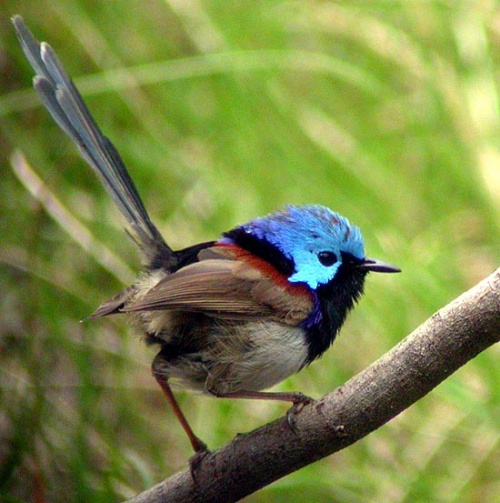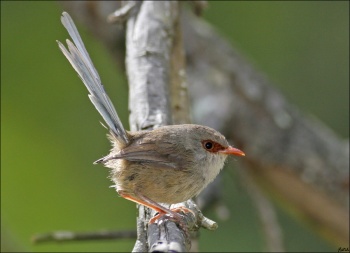(Picture of male transitioning to breeding plumage) |
m |
||
| Line 1: | Line 1: | ||
[[Image:Variegated_Fairywren.jpg|thumb|500px|right|Male<br /> Photo by {{user|Neil|Neil}}<br />Sydney, [[Australia]]]] | [[Image:Variegated_Fairywren.jpg|thumb|500px|right|Male<br /> Photo by {{user|Neil|Neil}}<br />Sydney, [[Australia]]]] | ||
;[[:Category:Malurus|Malurus]] lamberti | ;[[:Category:Malurus|Malurus]] lamberti | ||
| + | '''Includes: Purple-backed Fairywren''' | ||
==Identification== | ==Identification== | ||
11·5–14·5 cm (4½-5¾ in)<br /> | 11·5–14·5 cm (4½-5¾ in)<br /> | ||
| Line 27: | Line 28: | ||
:*Bernier Island, Western Australia | :*Bernier Island, Western Australia | ||
| − | + | IOC splits ''assimilis'' as Purple-backed Fairywren (including ''rogersi'', ''dulcis'' and ''bernieri''), leaving ''lamberti'' as monotypic. | |
| − | |||
==Habitat== | ==Habitat== | ||
Dense shrubby vegetation, including coastal scrub, rough rocky thicket areas and along creeks. | Dense shrubby vegetation, including coastal scrub, rough rocky thicket areas and along creeks. | ||
Revision as of 13:09, 3 February 2018
- Malurus lamberti
Includes: Purple-backed Fairywren
Identification
11·5–14·5 cm (4½-5¾ in)
Chestnut shoulders, blue crown and ear coverts; non-breeding males, females and juveniles have predominantly grey-brown plumage, but in non-breeding males, the bill and lores remain black. Both sexes have long dull-blue tails.
Variation
The color of the back of the breeding plumage male varies from sky blue to purple depending on subspecies.
Distribution
Taxonomy
Subspecies

Photo by Mzungu
Minnippi Parklands, Brisbane, Queensland, Australia, April 2017
Five subspecies are recognized[1]:
- M. l. rogersi:
- North East Northern Territory (Kimberley region)
- M. l. dulcis:
- Northern Northern Territory (central Arnhem Land)
- M. l. assimilis:
- Interior of Australia, extending to coasts in western Western Australia
- M. l. lamberti:
- South East Australia (Fitzroy River, Queensland to Bateman's Bay, New South Wales
- M. l. bernieri:
- Bernier Island, Western Australia
IOC splits assimilis as Purple-backed Fairywren (including rogersi, dulcis and bernieri), leaving lamberti as monotypic.
Habitat
Dense shrubby vegetation, including coastal scrub, rough rocky thicket areas and along creeks.
Behaviour
Diet
Their diet consists of insects such as ants, wasps, flies, grasshoppers, beetles etc.
References
- Clements, J. F., T. S. Schulenberg, M. J. Iliff, D. Roberson, T. A. Fredericks, B. L. Sullivan, and C. L. Wood. 2016. The eBird/Clements checklist of birds of the world: v2016, with updates to August 2016. Downloaded from http://www.birds.cornell.edu/clementschecklist/download/
- Birdforum thread discussing taxonomy of Fairywrens and related species
- Handbook of the Birds of the World Alive (retrieved September 2016)
Recommended Citation
- BirdForum Opus contributors. (2024) Variegated Fairywren. In: BirdForum, the forum for wild birds and birding. Retrieved 15 May 2024 from https://www.birdforum.net/opus/Variegated_Fairywren





